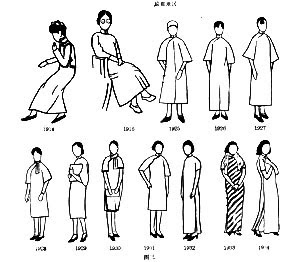The Qipao came from the Manchus who grew out of ancient Nuzhen tribes. In the early 17th century, Nurhachi, a great political and military strategist, unified the various Nuzhen tribes and set up the Eight Banners System. Over the years, a collarless, tube-shaped gown was developed, which was worn by both men and women. That is the embryo of the Qipao. The dress is called Qipao in Chinese or translated as "banner gown", for it came from the people who lived under the Banner System.
2. Development of Qipao
 Shanghai singsong girls in the 1930s (left)
Shanghai singsong girls in the 1930s (left)
In the 1930s, wearing a Qipao became a fashion among women in the whole of
Starting from the 1940s, Qipaos became closer-fitting and more practical. In summer, women wore sleeveless dresses. Qipaos of this period were seldom adorned with patterns.
Nancy Kwan, Life Magazine, October 24, 1960 (below)

Qipao didn't become standard female attire until the 1960s. Following Western fashion, the tailors raised the hem, even to above the knee, so that the "long" was no longer long.
Today, wearing a Qipao nowadays has turned into something of a vogue, both at home and abroad. Due to its elegance and classical looks, Qipao becomes a source of inspiration for fashion designers. World-renowned brands like CD, Versace, and Ralph Lauren have all cited some Qipao elements in their designs. Many foreign women are eager to get themselves a Qipao should they visit

. This series shows how women's dress changed from 1914 to 1949.The cut of the qipao changed constantly, as Chinese women's dress became much more subject to fashion than it ever had been before
3. Elements of Qipao
The collar

The collar of Qipao is high and tight fitting, not just for preventing coldness but also for beauty. The collar of Qipao generally takes the shape of a semicircle, its right and left sides being symmetrical, flattering the soft and slender neck of a woman. The collar of Qipao is meticulously made, especially the buttonhole loop on the collar, which serves as the finishing touch.
The slits
For convenient movement and display of the slender legs of women Qipao generally has two big slits at either side of the hem. The slits of Qipao expose a woman's legs indistinctly when she walks, as if there was a blurred emotional appeal of "enjoying flowers in mist". Today you can get Qipao with different lengths and kinds of slits (one slit on the side or front as well as two slits).
The material
The Qipao usually is made of excellent materials like silk, silk brocade, satin, satin brocade or velour's. Nearly all colors can be used. Often the Qipao gets a certain pattern, such as Chinese Dragons, different kinds of flowers, butterflies or other typical Chinese icons (e.g. prosperity, wealth).
(above) Zhang Ziyi, in JasmineFlower
With the certain searching marks, e.g. +,~,-, I could easily find the information that I was looking for. When I searched the information about Qipao, I think "-" was very useful for me. There are lots of websites selling Qipao, and obviously I don't need that. I did notice that it was very necessary to analyze if the information is reliable or not. Actually I deleted some that seemed not so reliable when I edited. After the online searching, I learned more about history about Qipao and viewed many movie stars' Qipao costumes. It's really a fun experience for me.


1 comment:
This post was so interesting! I love that you included lots of pics and simplified the text for everyone. I've always wanted a Qipao. I think it's very cheap to get one custom made in China these days and it comes in so many beautiful colors and design.
Post a Comment